
Hemimorphite is the chemical compound Zn4(Si2O7)(OH)2·H2O, a component of mineral calamine. It is a silicate mineral which, together with smithsonite (ZnCO3), has been historically mined from the upper parts of zinc and lead ores. Both compounds were originally believed to be the same mineral and classified as calamine. In the second half of the 18th century, it was discovered that these two different compounds were both present in calamine. They closely resemble one another.

Galena, also called lead glance, is the natural mineral form of lead(II) sulfide (PbS). It is the most important ore of lead and an important source of silver.
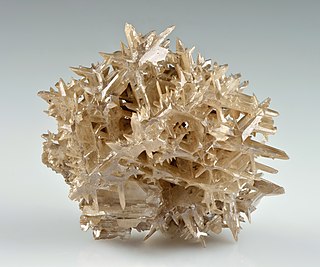
Cerussite (also known as lead carbonate or white lead ore) is a mineral consisting of lead carbonate with the chemical formula PbCO3, and is an important ore of lead. The name is from the Latin cerussa, white lead. Cerussa nativa was mentioned by Conrad Gessner in 1565, and in 1832 F. S. Beudant applied the name céruse to the mineral, whilst the present form, cerussite, is due to W. Haidinger (1845). Miners' names in early use were lead-spar and white-lead-ore.
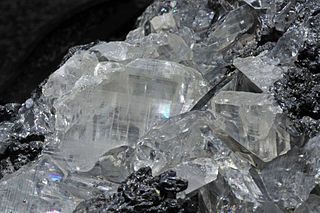
Anglesite is a lead sulfate mineral with the chemical formula PbSO4. It occurs as an oxidation product of primary lead sulfide ore, galena. Anglesite occurs as prismatic orthorhombic crystals and earthy masses, and is isomorphous with barite and celestine. It contains 74% of lead by mass and therefore has a high specific gravity of 6.3. Anglesite's color is white or gray with pale yellow streaks. It may be dark gray if impure.

Cotunnite is the natural mineral form of lead(II) chloride (PbCl2). Unlike the pure compound, which is white, cotunnite can be white, yellow, or green. The density of mineral samples spans range 5.3–5.8 g/cm3. The hardness on the Mohs scale is 1.5–2. The crystal structure is orthorhombic dipyramidal and the point group is 2/m 2/m 2/m. Each Pb has a coordination number of 9. Cotunnite occurs near volcanoes: Vesuvius, Italy; Tarapacá, Chile; and Tolbachik, Russia.

Caledonite, whose name derives from Caledonia, the historical name of its place of discovery (Scotland), is a richly colored blue-green sulfate-carbonate mineral of lead and copper with an orthorhombic crystal structure. It is an uncommon mineral found in the oxidized zones of copper-lead deposits.

Phosgenite is a rare mineral consisting of lead carbonate chloride, (PbCl)2CO3. The tetragonal crystals are prismatic or tabular in habit: they are usually colorless and transparent, and have a brilliant adamantine lustre. Sometimes the crystals have a curious helical twist about the tetrad or principal axis. The hardness is 3 and the specific gravity 6.3. The mineral is rather sectile, and consequently was earlier known as corneous lead, (German Hornblei).

Stolzite is a mineral, a lead tungstate; with the formula PbWO4. It is similar to, and often associated with, wulfenite which is the same chemical formula except that the tungsten is replaced by molybdenum. Stolzite crystallizes in the tetragonal crystal system and is dimorphous with the monoclinic form raspite.

Fraipontite is a zinc aluminium silicate mineral with a formula of (Zn,Al)3(Si,Al)2O5(OH)4.
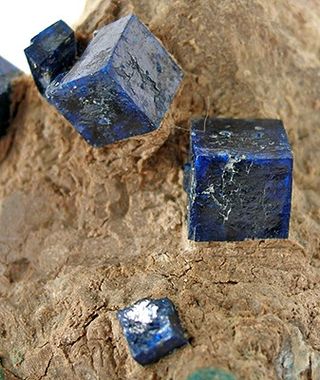
Boleite is a complex halide mineral with formula: KPb26Ag9Cu24(OH)48Cl62. It was first described in 1891 as an oxychloride mineral. It is an isometric mineral which forms in deep-blue cubes. There are numerous minerals related to boleite, such as pseudoboleite, cumengite, and diaboleite, and these all have the same complex crystal structure. They all contain bright-blue cubic forms and are formed in altered zones of lead and copper deposits, produced during the reaction of chloride bearing solutions with primary sulfide minerals.

Anthonyite is a hydrous secondary copper halide mineral with chemical formula of Cu(OH,Cl)2·3(H2O).
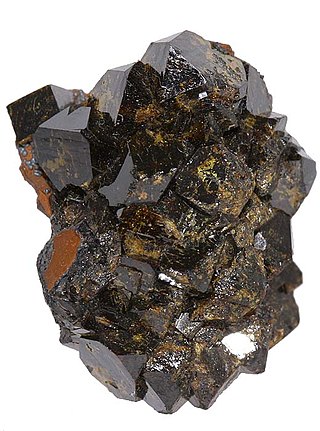
Beudandite is a secondary mineral occurring in the oxidized zones of polymetallic deposits. It is a lead, iron, arsenate, sulfate with endmember formula: PbFe3(OH)6SO4AsO4.

Tsumebite is a rare phosphate mineral named in 1912 after the locality where it was first found, the Tsumeb mine in Namibia, well known to mineral collectors for the wide range of minerals found there. Tsumebite is a compound phosphate and sulfate of lead and copper, with hydroxyl, formula Pb2Cu(PO4)(SO4)(OH). There is a similar mineral called arsentsumebite, where the phosphate group PO4 is replaced by the arsenate group AsO4, giving the formula Pb2Cu(AsO4)(SO4)(OH). Both minerals are members of the brackebuschite group.

Matlockite is a rare lead halide mineral, named after the town of Matlock in Derbyshire, England, where it was first discovered in a nearby mine. Matlockite gives its name to the matlockite group which consists of rare minerals of a similar structure.

Tsumcorite is a rare hydrated lead arsenate mineral that was discovered in 1971, and reported by Geier, Kautz and Muller. It was named after the TSUMeb CORporation mine at Tsumeb, in Namibia, in recognition of the Corporation's support for mineralogical investigations of the orebody at its Mineral Research Laboratory.

Semseyite is a rarely occurring sulfosalt mineral and is part of the class of lead antimony sulfides. It crystallizes in the monoclinic system with the chemical composition Pb9Sb8S21. The mineral forms dark gray to black aggregates.

Chloroxiphite is a rare olive green to pistacio green lead copper halide mineral with formula: Pb3CuO2Cl2(OH)2.

Paralaurionite is a colorless mineral consisting of a basic lead chloride PbCl(OH) that is dimorphous with laurionite. It is a member of the matlockite group. The name is derived from para-, the Greek for "near", and laurionite, because of its polymorphic relationship to it. Bright, yellow tips of thorikosite can form on paralaurionite crystals and paralaurionite may also be intergrown with mendipite.
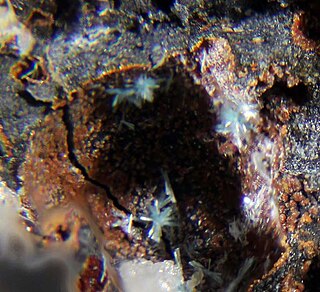
Mammothite is a mineral found in the Mammoth mine in Tiger, Arizona and also in Laurium, Attika, Greece. This mineral was named in 1985 by Donald R. Peacor, Pete J. Dunn, G. Schnorrer-Köhler, and Richard A. Bideaux, for the Mammoth vein (one of the two main veins in the mine) and the town of Mammoth, Arizona, which was named for the mine. The mammothite that is found in Arizona exist as euhedral crystals imbedded in micro granular, white colored anglesite with a saccharoidal texture. The associated minerals include phosgenite, wulfenite, leadhillite and caledonite. In Greece, the mammothite exists as small euhedral crystals and also as microscopic rock cavities lined with projecting crystals within the slags. The associated minerals here are cerussite, phosgenite and matlockite. The ideal chemical formula for mammothite is Pb6Cu4AlSb5+O2(OH)16Cl4(SO4)2.

Penfieldite is a rare lead hydroxychloride mineral from the class of halides. It was named after Samuel Lewis Penfield. It has been a valid species before the founding of IMA, and was first published in 1892. It had been grandfathered, meaning the name penfieldite is still believed to refer to a valid species. When it was first described by Genth in 1892 from Laurion, Greece, the mineral had the formula of Pb3Cl4O.




















